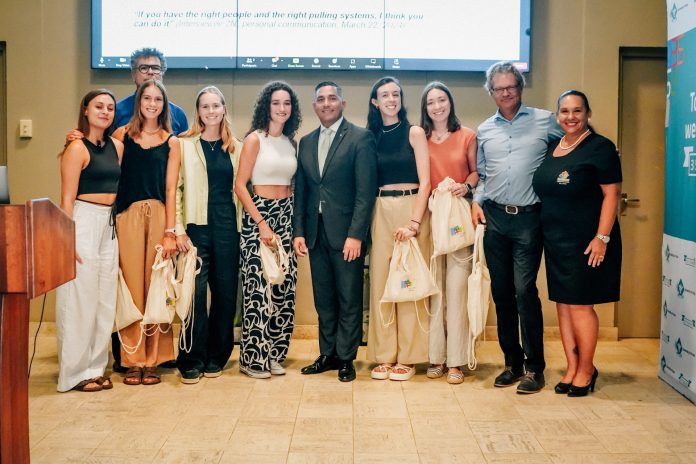On April 8th, a group of students from the University of Utrecht, namely Ilse Coelman, Sara Ståhlberg, Martha Ramos Monzón, Yoshi Montoya Rodriguez, Gemma Negrini, and Yanina Diaz-Maroto Knöfler, presented the results of their preliminary study conducted in collaboration with Santa Rosa and the University of Aruba.
The presentation was attended by Minister Mr. Ursell Arends as well as a significant number of guests from various private and governmental sectors. The theme centered on the possibility of rainwater harvesting in Aruba and the potential it holds for the island’s Agricultural sector as a commercial endeavor. This study was part of the Erasmus exchange program stationed at the University of Aruba.
The Department of Agriculture, Livestock, and Fisheries (Santa Rosa) acted as their client, with Mrs. Nathalie Maduro, Director of DLVV-Santa Rosa, coordinating the project alongside Mr. Eric Mijts from the University of Aruba. Mr. Facundo Franken, responsible for the local plant section, oversaw the supply of past reports that served as comparative information to the current situation. He also coordinated visits to various plantation localities and farms. The objective of these visits was to illustrate the practice of rainwater collection via dams, gutters, rain barrels, plastic tanks with a capacity of over 3000L, or 1000L white tanks.
The students collected data and analyzed the different results from two perspectives: evaluating opportunities for the Agricultural Sector and facilitating the use of water for other purposes within the community. They divided their study and evaluation work into two groups of three. One group focused on the implementation of rainwater collection, while the other concentrated on community readiness to collect, reuse, and contribute to the sustainability of homes or businesses. As part of their study, they reviewed literature on rainwater collection in Aruba and conducted structured interviews with various stakeholders and a public survey. They recorded and evaluated the suggestions and practices provided by the community regarding rainwater collection.
From the collected data, they selected the most accessible options and concluded that using aluminum gutters connected to 1000L plastic tanks would be the most cost-effective method for individuals interested in rainwater collection at their homes. On the other hand, they suggested that agroforestry might be the most beneficial practice for rainwater collection, directly into the soil, enhancing its fertility and moisture retention. Agroforestry combines agriculture and forestry, where trees of various products are cultivated alongside the main crop for additional benefits.
Many farmers prefer to use all water and light resources solely for cultivation. However, the soil’s fertility and its ability to retain moisture may decrease over time without diversifying crops, affecting future cycles. Kravchencko et al. in 2019 demonstrated that root diversity creates a diversity of soil pores that stabilize carbon levels and increase soil moisture. This method of rainwater collection offers water directly to crops but may not be available for other uses.
The students’ conclusion highlighted that, unlike other Caribbean islands, Aruba relies less on rainwater harvesting due to its access to desalinated water from the Water and Energy Company NV (WEB). Historically, the island has invested in natural water sources, intensifying their use through deeper wells and more extensive cisterns. In 1933, a seawater distillation company was established in Balashi. The students noted that in the past, many farmers found stable employment in the island’s two refineries, shifting the focus away from agriculture for survival.
One of the recommendations made by the students was to improve communication within the community regarding responsible and practical rainwater harvesting. During the Q&A session, an audience member asked for examples of effective rainwater collection, to which the students referred to the Santa Cruz Craft School, where interconnected tanks of various sizes were used for collection.

















